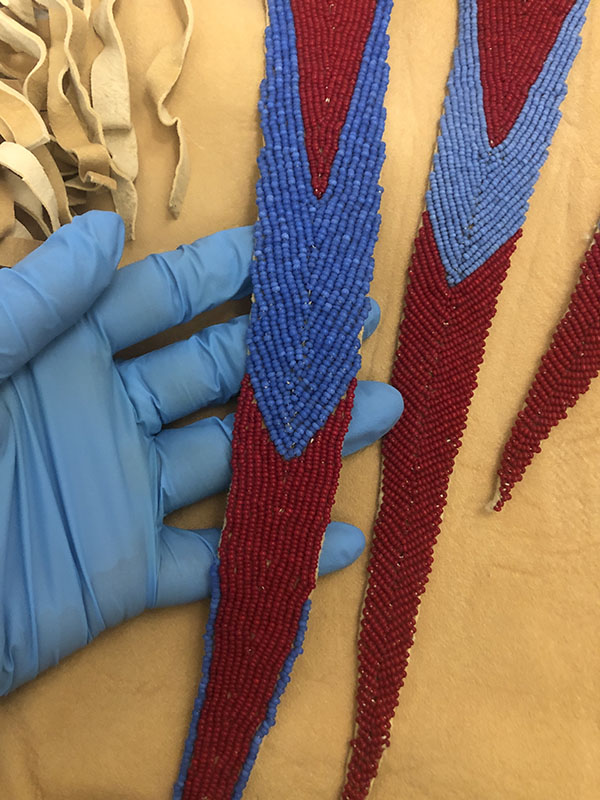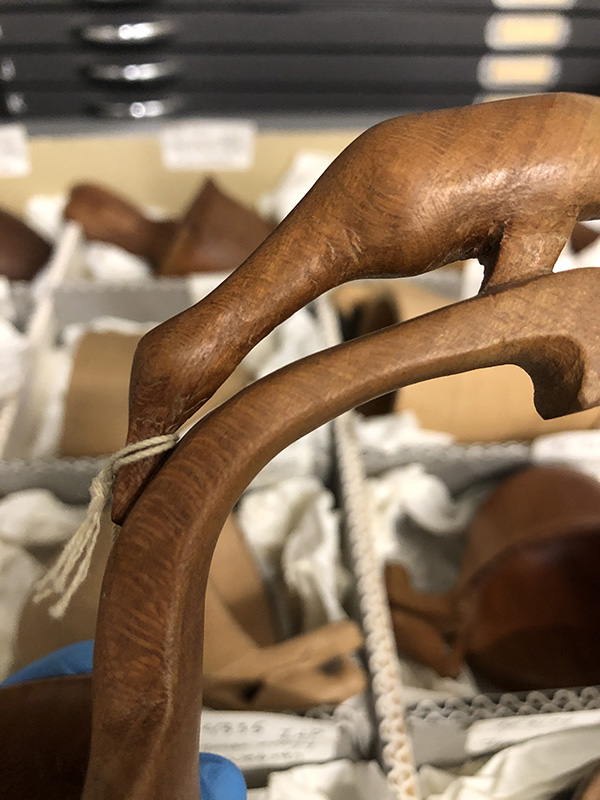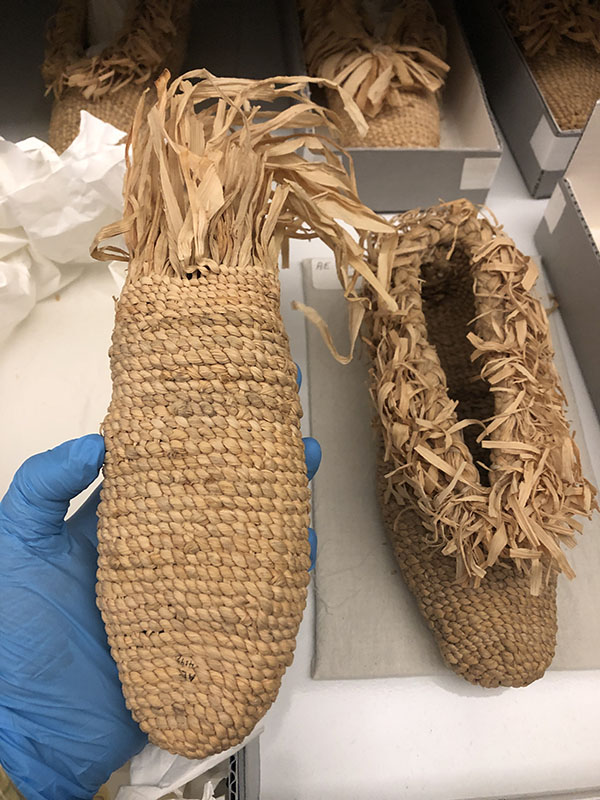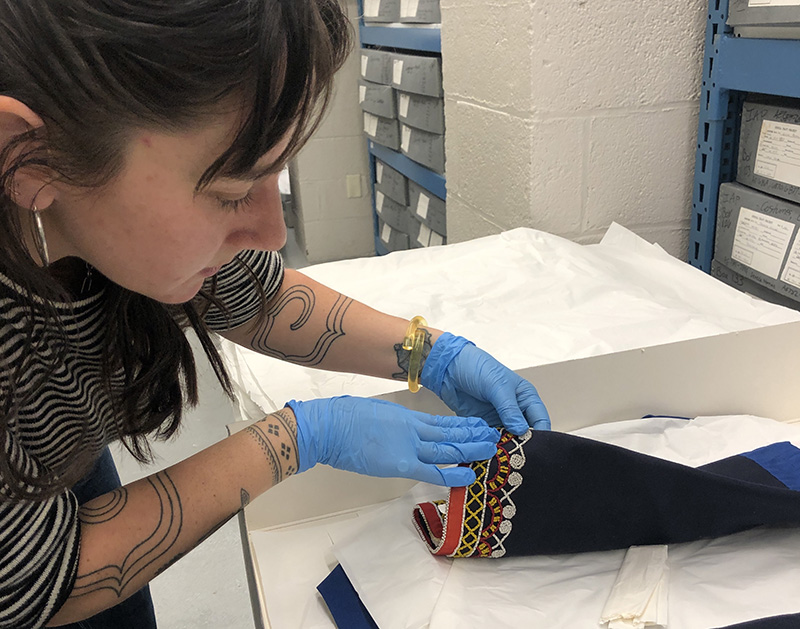Haudenosaunee Craft at the Rochester Municipal Museum: A Paradoxical New Deal Project
by Julia Silverman
Beginning in 1935, approximately 100 Haudenosaunee artists were hired by the Rochester Municipal Museum (now called the Rochester Museum & Science Center) to manufacture a new ethnographic collection. Led by Arthur C. Parker, the museum’s director and an anthropologist of Seneca descent, and funded by New Deal federal relief agencies, these artists produced over 5,000 objects, including beaded and quilled moccasins, burden straps, wooden carvings, masks, and other items that cataloged Seneca artistic knowledge. Although the project was inspired by period ethnography—Parker’s original aim had been to “replace” a destroyed collection of Lewis Henry Morgan—the Indian Arts Project (IAP), as Parker called it, represented an opportunity to promote a new form of “living museum,” a historical collection with a forward-looking social mission. Noting that Seneca artists were gradually adopting a Plains aesthetic, Parker sought to re-acquaint Seneca people with objects and craft methods specific to their communities and ancestors.
These aims resulted in the production of a collection that embodies many of the paradoxes and contradictions of its conception. During a period when collections of Native-made items largely operated on a colonial presumption of salvage—that they were preserving objects otherwise in danger of going extinct—the IAP was also channeling anxieties about “deculturation,” to use Parker’s term, into a celebration of living tradition. Sarah Hill of the Tonawanda Reservation, for example, was one of the last remaining community members to weave burden straps out of basswood bark. Through the project, she was able to teach bark processing and weaving to several other community members who then used WPA funding to experiment with new weave structures and dye methods.
At the same time, the project was challenging the presumed role of anthropology as a disinterested reporter of cultural information; instead, Parker was actively directing project participants to recreate designs and objects found in other ethnographic collections, using anthropological accounts as a catalyst for ongoing production. Finally, even as the project aimed to preserve Seneca ways of being, it inadvertently complicated the relationship between secular and sacred. Parker assumed that commissioning ceremonial objects for the museum would secularize them for non-Seneca viewers, but more recent responses to the project have revealed the ongoing cultural dangers inherent to Parker’s assumptions. Today, several objects in the collection have been repatriated to the Seneca Nation, while others remain restricted to outside researchers. Some of these items constitute sacred objects or objects of cultural patrimony, two categories specified by NAGPRA (the Native American Graves Protection and Repatriation Act), a 1990 law governing museum repatriations between federally funded museums and federally recognized tribes. Other items, due to Seneca cultural protocols, must only be viewed by people holding certain positions within Seneca society; out of respect for these protocols, I did not view or conduct research on these items. Meanwhile, the Rochester Museum and Science Center (RMSC) maintains an ongoing relationship with representatives of the Seneca Nation and the Tonawanda Band of Seneca to ensure community access to the collection, which was likely Parker’s intent.
With Research Grant funding from the Decorative Arts Trust, I was finally able to visit the collection to grapple with these paradoxes in person. Because the collection is not digitized, access to the IAP was contingent upon my travel to Rochester. Thankfully, with the support of Kathryn Murano and Chelsea Vasquez of the RMSC, I spent a week in the museum’s collections and archives, looking closely at objects and records for thousands of items produced during the project. Stemming from Parker’s intention that the IAP be a living collection, I was permitted exceptionally close access: to feel the texture of hide shirts (with gloves, of course), the texture of the quillwork and beads on moccasins, and the smoothness of cured wood and woven basswood. Touching and smelling, in addition to looking, became integral to my experience. Meanwhile, I was able to see details previously unavailable to me: often, clothing items were made to be worn by specific people, usually other IAP workers. Being able to closely observe wear and mending patterns, in addition to original construction techniques, provided a sense of how maintenance, in a material sense, is critical to living craft knowledge.
Seeing the collection in person also complicated many of Parker’s stated claims about the collection as “traditionally” Seneca. Coming to the collection, I was under the impression that the vast majority of items had been copied directly from the Morgan collection. In certain instances, this was the case. In others, however, IAP artists took significant liberties in creating original designs. Masonic symbols, for example, abounded in the project’s silver collection, and engraved gorgets were sometimes incised with images that seemed to reference stereotyped Native people, as seen in period illustrations. In the archives, artists remarked at making ceremonial objects to resemble figures from pop culture, whether the wicked stepmother in Disney’s Snow White, released in 1937, or comedienne Fanny Brice. These findings do not contradict the collection’s authenticity. They do, however, point to a more elastic conception of ethnographic authenticity that I had assumed Parker had. They also position a collection that might otherwise be understood as strictly historical squarely in dialogue with the modern culture in which it was created.
The opportunity to immerse myself in the collection changed the questions I asked as a researcher. I am still interested, for example, in how outside anthropologists viewed the collection in terms of period anthropological practice. However, as I became acquainted with the work of various individuals, I became much more interested in the long life of the project at Cattaraugus and Tonawanda, the reservations where it took place. While I was in Rochester, Jamie Jacobs, who is a steward of the collection from Tonawanda, discussed how certain types of items fell out of favor after the conclusion of the IAP while others flourished. Jacobs’ insight prompted me to think more about how present-day histories and usages of the collection might be enfolded into historical narratives. In a later conversation with Jacobs, he discussed how most of the published research on the collection had been about (esoteric) sacred items and emphasized a need to bring information about the collection’s non-sacred items back to Tonawanda. Finding a medium to make my research accessible to Seneca community members continues to dictate how I approach this project going forward. To that end, I hope to return to Rochester in the coming year to learn more from descendants of project participants and am thankful for the opportunity to begin asking questions of this collection.
Julia Silverman is a PhD candidate in History of Art and Architecture at Harvard University.
About The Decorative Arts Trust Bulletin
Formerly known as the "blog,” the Bulletin features new research and scholarship, travelogues, book reviews, and museum and gallery exhibitions. The Bulletin complements The Magazine of the Decorative Arts Trust, our biannual members publication.
Click Images to Enlarge
Did you know that clicking on the images in Bulletin posts will allow you to get a closer look? Simply click on an image, and a larger version will open in a pop-up window.











